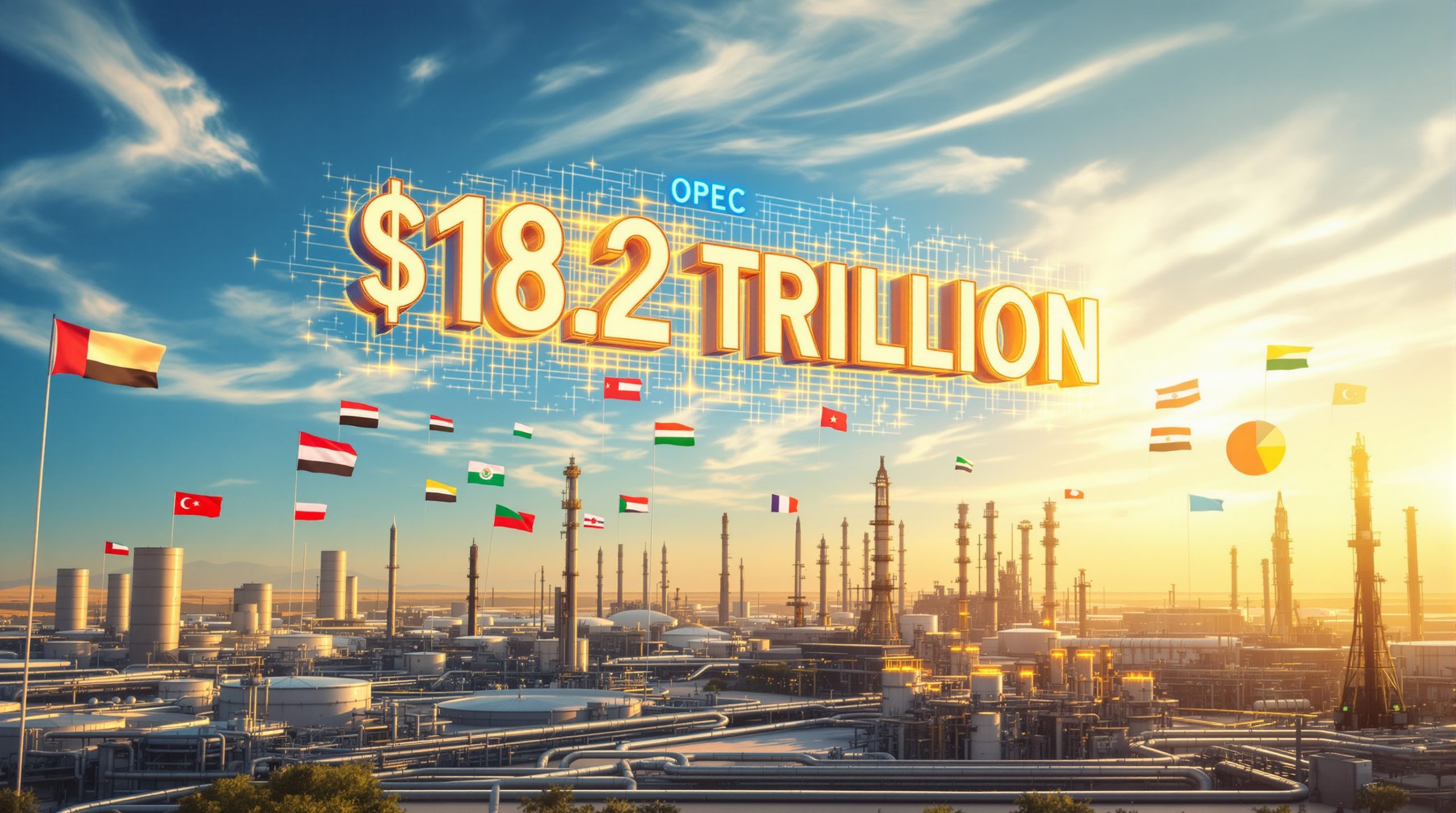Why Is Barite Critical to America's Energy Independence?
What Makes Barite Essential for US National Security
The United States faces a striking vulnerability in its critical mineral supply chains, with barite standing as one of the most strategically important yet overlooked minerals in the nation's energy security framework. The US Geological Survey officially recognized barite as a critical mineral in 2018, a designation reaffirmed through 2023, highlighting its fundamental role in maintaining America's energy independence and national security infrastructure. The critical minerals energy transition continues to shape strategic planning across multiple sectors.
Barite, chemically known as barium sulfate (BaSO4), serves as the backbone of America's petroleum extraction industry. This dense mineral, with its exceptional specific gravity ranging from 4.2 to 4.5, functions as a crucial weighting agent in drilling fluids, preventing dangerous blowouts by counterbalancing formation pressures during oil and gas extraction operations. The petroleum sector consumes approximately 85-90% of all domestic barite, making any supply disruption potentially catastrophic for energy production.
Critical Supply Chain Vulnerabilities:
• Supply disruptions could trigger approximately $1 billion in GDP losses for the United States
• Petroleum drilling operations require 3-5 tonnes of barite per well depending on depth and formation characteristics
• Medical sector dependency for radiocontrast agents in X-ray imaging and CT scans
• Defense applications through energy sector support and specialized drilling operations
The economic implications extend far beyond the mining sector. When drilling operations halt due to barite shortages, the cascading effects impact refinery operations, fuel distribution networks, and ultimately consumer energy prices. This interconnectedness places barite among the most supply-critical minerals in America's strategic resource portfolio, highlighting the defence supply chain crisis affecting multiple industries.
How Severe Is America's Barite Import Dependency Crisis?
Current Import Statistics and Vulnerabilities
America's barite dependency crisis represents one of the most severe import reliance scenarios among critical minerals. The nation consumes approximately 2.2 million metric tonnes of barite annually, yet domestic production contributes only about 332,000 metric tonnes, representing merely 15% of total consumption. This dramatic supply-demand imbalance has pushed import reliance to approximately 85% in 2023, up from 75% in 2015.
Import Dependency Breakdown:
| Import Source | Percentage of Total Imports | Supply Risk Factors |
|---|---|---|
| India | 34% | Monsoon disruptions, port capacity |
| China | 20% | Trade tensions, export restrictions |
| Morocco | 18% | Political stability, logistics |
| Mexico | 12% | Infrastructure limitations |
| Others | 16% | Various regional risks |
The USGS characterises barite supply as having "medium" supply risk coupled with "high" importance to national security, creating a concerning risk profile. This classification reflects the mineral's critical role in petroleum extraction operations where even minor supply interruptions can cascade into significant economic disruptions.
Major Import Sources and Associated Risks
China's position as both a major supplier and the world's largest barite producer presents particular strategic challenges. Despite accounting for 20% of US imports, China produces approximately 30-35% of global barite supply, giving it substantial market influence. The US-China trade impact creates ongoing uncertainty for American consumers through potential export restrictions.
India's dominance as the primary supplier, providing 34% of US imports, concentrates significant risk in a single source. Monsoon seasons can disrupt mining operations and port activities, while infrastructure limitations occasionally constrain export capacity. Morocco and Mexico, whilst geographically advantageous for different US regions, each present unique logistical and political considerations.
Transportation costs compound these vulnerabilities, representing 25-40% of delivered costs depending on origin and destination. West Coast operations face particularly high costs when sourcing from Atlantic basin suppliers, creating economic inefficiencies that ultimately impact energy production costs.
What Is the Palmer VMS Project's Strategic Position?
Project Location and Infrastructure Advantages
The Palmer VMS Project stands uniquely positioned to address America's barite supply chain vulnerabilities through its strategic location in Southeast Alaska. Located approximately 35 miles northwest of Haines, the project benefits from existing road access via the Haines Highway and proximity to tidewater port facilities, providing crucial infrastructure advantages for potential barite production and distribution.
Southeast Alaska's geographical position offers exceptional access to both domestic West Coast markets and international shipping routes. The region's proximity to Pacific shipping lanes enables delivery to West Coast US markets within 1-2 days, compared to 15-30 day transit times from traditional Asian suppliers. This proximity advantage could fundamentally alter the economics of barite supply to America's largest petroleum production regions, particularly as advanced mining technology continues to evolve.
Infrastructure Advantages:
• Direct road access reducing transportation costs and complexity
• Tidewater port proximity enabling efficient bulk mineral shipping
• Strategic position for serving Western US petroleum operations
• Established mining jurisdiction with predictable regulatory framework
• Existing support infrastructure in nearby Haines community
The project's infrastructure advantages extend beyond mere logistics. Alaska's established mining regulatory framework and experienced workforce provide operational benefits that emerging mining jurisdictions often lack. This combination of location, infrastructure, and regulatory certainty positions Palmer as a potentially transformative asset for US barite supply security.
Geological Formation and Resource Classification
Palmer represents a classic Volcanogenic Massive Sulfide (VMS) deposit, formed through ancient submarine hydrothermal activity that concentrated multiple valuable minerals in a single geological system. VMS deposits typically host copper, zinc, lead, gold, silver, and in Palmer's case, significant barite concentrations, making them among the most economically attractive polymetallic mining targets.
The project's Palmer VMS Project barite supply chain potential stems from its NI 43-101 compliant resource estimate, which provides internationally recognised confidence levels for mineral resource reporting. This technical standard ensures that resource estimates meet rigorous geological and statistical criteria, providing investors and policymakers with reliable data for strategic planning.
Geological Characteristics:
• VMS formation through submarine hydrothermal processes
• Polymetallic system hosting barite alongside base and precious metals
• Geological confidence supporting advanced exploration and development planning
• Mineral associations typical of world-class VMS deposits
• Structural controls favourable for selective underground mining methods
The deposit's polymetallic nature offers significant economic advantages over standalone barite operations. By extracting multiple valuable minerals from the same ore body, Palmer could achieve lower unit costs for barite production whilst generating additional revenue streams from copper, zinc, gold, and silver recovery.
How Significant Are Palmer's Barite Resources?
Resource Estimates and Market Impact Potential
Palmer's barite resources represent a potentially game-changing supply source for American markets. The project hosts 980,000 tonnes of barite in the Indicated resource category and an additional 3.05 million tonnes in the Inferred category, totaling 4.03 million tonnes of potential barite supply, as reported by American Pacific Mining.
Resource Significance Analysis:
| Resource Category | Barite Tonnage | US Consumption Equivalent | Confidence Level |
|---|---|---|---|
| Indicated Resources | 980,000 tonnes | 5.3 months supply | High |
| Inferred Resources | 3.05 million tonnes | 16.7 months supply | Moderate |
| Total Potential | 4.03 million tonnes | 22 months supply | Combined |
These resource estimates, based on 2023 US annual consumption of approximately 2.2 million tonnes, demonstrate Palmer's potential to meaningfully impact American barite supply security. The Indicated resources alone could supply over five months of total US consumption, whilst the combined resource base represents nearly two years of current demand levels.
The strategic importance becomes even more pronounced when considering that Palmer's Indicated resources could potentially supply approximately 9% of annual US consumption if developed over a typical mine life. This level of domestic production could reduce America's import dependency from 85% to approximately 76%, representing a significant step toward supply chain resilience and supporting the defence critical materials strategy.
Quality Specifications and Market Readiness
The 2018 SGS Canada Inc. metallurgical testing results validate Palmer's barite quality for immediate market application. The testing demonstrated that premium-quality barite concentrate meeting all oilfield drilling specifications can be produced from Palmer's ore, including critical parameters for specific gravity, particle size, and chemical purity.
Quality Validation Results:
• 91.1% barite recovery efficiency from copper-zinc flotation tails
• Meeting API drilling-grade specifications including minimum 4.20 specific gravity
• Achieving required brightness standards exceeding 87% minimum threshold
• Particle size compliance with 97% passing 200-mesh screen requirements
• Chemical purity meeting maximum 250 mg/kg soluble alkaline earth metals specification
"The simple flowsheet design achieving 91.1% recovery rates represents exceptionally high efficiency for barite extraction, comparing favourably with industry standard recovery rates of 85-93% from standalone operations."
This quality validation eliminates a critical development risk, demonstrating that Palmer's barite concentrate requires no additional processing or beneficiation to meet market standards. The ability to produce market-ready concentrate from existing flotation processes significantly enhances the project's economic viability and time-to-market potential.
What Makes Palmer's Processing Approach Unique?
Flotation Recovery Technology
Palmer's processing approach represents a significant advancement in barite extraction efficiency through its integrated flotation recovery system. The demonstrated 91.1% barite recovery from copper-zinc flotation tails showcases a sophisticated understanding of mineral processing chemistry that maximises valuable mineral extraction from a single ore body.
Flotation technology operates through physicochemical separation processes where mineral particles attach to air bubbles based on surface chemistry differences. Palmer's success in achieving premium recovery rates stems from optimised flotation conditions that selectively separate barite from other sulfide minerals whilst maintaining high-grade concentrate specifications.
Processing Innovation Benefits:
• Simple flowsheet design minimising capital and operating costs
• High-efficiency recovery rates exceeding typical industry standards
• Integrated approach eliminating separate barite processing facilities
• Proven metallurgy reducing technical development risks
• Scalable technology suitable for various production rates
The technological approach addresses one of the primary challenges in barite extraction: achieving high recovery rates whilst maintaining strict quality specifications. Palmer's success in producing API-compliant concentrate through a streamlined process provides a significant competitive advantage over more complex processing operations.
Integrated Mining Strategy Benefits
Palmer's integrated mining strategy leverages the economic synergies inherent in polymetallic VMS deposits. By extracting copper, zinc, gold, silver, and barite from a single underground operation, the project can distribute infrastructure costs across multiple revenue streams, fundamentally improving the economics of barite production.
The planned 3,500 tonnes per day processing capacity, operating approximately 350 days annually, would generate roughly 1.225 million tonnes of annual throughput. This scale enables efficient extraction of all contained valuable minerals whilst maintaining cost-effective barite recovery as an integrated byproduct.
Integrated Strategy Advantages:
• Shared infrastructure costs across multiple mineral products
• Underground stoping methods enabling selective high-grade extraction
• Multi-metal revenue streams supporting barite production economics
• Operational flexibility to optimise production based on market conditions
• Risk diversification across multiple commodity markets
Underground stoping methods, commonly employed in VMS deposits, allow for selective extraction of high-grade ore zones whilst leaving waste rock in place. This approach maximises valuable mineral recovery whilst minimising environmental impact and operational costs, creating a sustainable foundation for long-term barite production.
How Could Palmer Transform US Barite Supply Security?
Domestic Production Impact Analysis
Palmer's potential contribution to US barite supply chain security extends far beyond its resource tonnage. If developed to extract its Indicated resources over a typical 5-year mine life, Palmer could supply approximately 196,000 tonnes of barite annually, representing about 9% of current US consumption and meaningfully reducing import dependency.
This domestic production capacity could transform regional supply dynamics, particularly for West Coast petroleum operations currently dependent on Asian imports. By providing a reliable North American source with superior logistics and reduced transportation costs, Palmer could establish a new supply paradigm for critical US energy infrastructure.
Supply Security Transformation:
• Import dependency reduction from 85% to approximately 76%
• Regional supply chain resilience for West Coast operations
• Strategic buffer against international trade disruptions
• Enhanced negotiating position with international suppliers
• Foundation for potential strategic stockpile development
The project's impact extends beyond immediate supply benefits. Establishing domestic barite production capability provides the United States with enhanced supply chain resilience, reducing vulnerability to geopolitical tensions, trade disputes, or natural disasters affecting international suppliers. This strategic value often exceeds the direct economic benefits of domestic production.
Economic Benefits Beyond Mining Operations
Palmer's development would generate substantial economic benefits throughout Alaska's resource sector and beyond. Mining operations typically create employment multiplier effects, where each direct mining job supports additional positions in supporting industries, transportation, and regional services.
The project's strategic location in Southeast Alaska positions it to contribute to the region's economic diversification efforts. As traditional industries face various challenges, mining development can provide stable, high-paying employment opportunities that support community sustainability and growth.
Economic Impact Categories:
• Direct employment in mining, processing, and transportation operations
• Indirect job creation in supply chain and support services
• Tax revenue generation for local and federal governments
• Regional economic multiplier effects supporting community development
• Infrastructure development benefits extending beyond mining operations
Federal and state tax revenues from Palmer's development could support broader critical mineral initiatives, creating a positive feedback loop that strengthens America's overall strategic mineral security. These revenues, combined with the project's demonstration effects, could encourage additional domestic critical mineral development projects.
What Are the Broader Market Implications?
Critical Minerals Strategy Alignment
Palmer's development aligns perfectly with evolving US critical minerals strategy, which recognises the fundamental importance of domestic supply chain security for economic and national defence priorities. The project encompasses multiple critical minerals designated by the USGS, including copper, zinc, gold, silver, and barite, making it a comprehensive strategic asset.
The 2022 reaffirmation of barite's inclusion on the Critical Minerals List reflects growing recognition of its strategic importance. Among the 50 mineral commodities deemed critical to US economic and national security, barite stands out for its direct connection to energy production and the severity of current import dependency.
Strategic Alignment Factors:
• Multiple critical minerals in single development project
• Direct support for energy independence objectives
• Alignment with Defense Production Act priorities
• Integration opportunity with Infrastructure Investment and Jobs Act funding
• Model project for future domestic critical mineral development
Recent commodity price performance further validates Palmer's strategic timing. Gold and silver prices have increased 60% and nearly 80% respectively since early 2025, whilst copper and zinc maintain strong demand profiles driven by electrification and infrastructure development. This multi-commodity strength provides enhanced economic viability for integrated barite production.
Competitive Advantages Over Import Sources
Palmer offers distinct competitive advantages over traditional import sources that extend beyond cost considerations. The project's North American location provides supply chain transparency, regulatory predictability, and quality consistency that international sources cannot match.
Transportation logistics represent a fundamental competitive advantage. Whilst Asian suppliers require 15-30 day shipping times to West Coast markets, Palmer could potentially deliver barite concentrate within 1-2 days of production. This proximity advantage becomes particularly valuable during supply disruptions or periods of high drilling activity when rapid response capability commands premium pricing, as highlighted in industry reports.
Competitive Advantage Matrix:
| Factor | Palmer Project | International Suppliers |
|---|---|---|
| Delivery Time | 1-2 days | 15-30 days |
| Supply Reliability | High predictability | Weather/political risks |
| Quality Consistency | Proven specifications | Variable by source |
| Currency Risk | USD denominated | Foreign exchange exposure |
| Trade Risk | Minimal | Tariff/restriction exposure |
The project's ability to produce consistent, high-quality concentrate through proven metallurgy eliminates quality variability concerns that occasionally affect international suppliers. This reliability factor becomes increasingly valuable as drilling operations demand strict specifications for successful completion.
What Challenges Must Palmer Overcome?
Development Timeline and Capital Requirements
Palmer faces the typical challenges associated with advancing from exploration to production, requiring completion of comprehensive economic studies, environmental assessments, and regulatory approvals. The project currently holds NI 43-101 compliant resource estimates but requires additional technical studies including Preliminary Economic Assessment and potentially Feasibility Studies before production decisions.
Alaska's mining development timeline typically ranges from 5-10 years depending on project complexity, permitting requirements, and financing availability. Palmer's advanced exploration status and existing infrastructure access provide advantages in this timeline, though comprehensive development planning remains essential for successful advancement.
Development Phase Requirements:
• Preliminary Economic Assessment establishing project viability
• Environmental baseline studies and impact assessments
• Engineering design for mining and processing facilities
• Regulatory permitting under state and federal jurisdiction
• Project financing and partnership development
Capital requirements for underground VMS operations vary significantly based on scale, depth, and processing complexity. Palmer's integrated processing approach and existing infrastructure access may reduce capital intensity compared to greenfield developments, though specific cost estimates require detailed engineering studies.
Market Competition and Pricing Dynamics
Entering the established barite market presents significant competitive challenges, as existing suppliers benefit from decades of customer relationships, proven quality track records, and developed logistics infrastructure. Palmer must demonstrate not only competitive pricing but also superior reliability and service to gain market share.
Barite pricing demonstrates historical volatility, ranging from $100-200 per tonne for API-grade material with 2023 average US import unit values approximately $197 per tonne. This price volatility reflects the direct correlation between barite demand and oil and gas drilling activity levels, which fluctuate based on commodity prices and industry investment cycles.
Market Entry Challenges:
• Established supplier relationships requiring competitive differentiation
• Price volatility based on drilling activity cycles
• Long-term contract negotiation complexity with major consumers
• Quality verification and customer approval processes
• Market timing coordination with production startup
Successfully penetrating established supply relationships requires demonstrating clear value propositions beyond price competition. Palmer's advantages in delivery speed, supply reliability, and strategic location provide differentiation opportunities, though converting these advantages into market share requires sustained marketing and customer development efforts.
How Does Palmer Fit Into Future Supply Chain Strategies?
Integration with US Energy Security Goals
Palmer's Palmer VMS Project barite supply chain contribution aligns directly with broader US energy security objectives as domestic oil and gas production continues at record levels. With approximately 12.9 million barrels per day crude oil production and 103.7 billion cubic feet per day natural gas production in 2023, America's drilling activity requires secure, reliable barite supply to maintain operational continuity.
The Department of Energy has emphasised securing domestic supply chains for critical minerals supporting energy production, though specific barite initiatives remain limited compared to battery metals and rare earth elements. Palmer's development could serve as a model for integrating critical mineral security with traditional energy sector requirements.
Energy Security Integration:
• Direct support for domestic petroleum extraction operations
• Supply chain localisation reducing international dependencies
• Strategic reserve development potential for national security
• Climate resilience planning for critical resource access
• Integration with renewable energy infrastructure development requirements
Future energy development, including geothermal and carbon capture projects, may increase barite demand beyond traditional petroleum applications. Palmer's position to serve these emerging markets whilst maintaining traditional oil and gas supply provides strategic flexibility for evolving energy security requirements.
Technology and Innovation Opportunities
Palmer's development presents opportunities for advancing mining technology and sustainable practices that could benefit broader critical mineral development initiatives. The project's integrated processing approach and polymetallic extraction methods offer innovation platforms for optimising complex mineral recovery systems.
Digital supply chain management technologies could enhance Palmer's competitive position by providing real-time inventory tracking, predictive maintenance capabilities, and automated quality control systems. These innovations would strengthen supply reliability whilst reducing operational costs, creating sustainable competitive advantages in the barite market.
Innovation Development Areas:
• Advanced flotation technology optimisation for multi-mineral systems
• Sustainable mining practice implementation and demonstration
• Digital supply chain management integration
• Environmental impact minimisation through technological advancement
• Automation integration for improved safety and efficiency
The project's success in implementing advanced technologies and sustainable practices could establish benchmarks for future domestic critical mineral developments, contributing to broader industry advancement whilst enhancing Palmer's own operational capabilities.
What Are the Investment and Development Prospects?
Corporate Strategy and Partnership Opportunities
American Pacific Mining Corp.'s focus on advancing Palmer reflects broader strategic positioning within North America's critical mineral development landscape. As a junior exploration and development company, American Pacific faces typical challenges associated with project advancement whilst benefiting from Palmer's unique strategic value proposition.
The company's emphasis on precious and base metal projects throughout North America provides diversification whilst concentrating expertise in familiar geological and regulatory environments. Palmer's multi-commodity nature and critical mineral designation enhance its strategic value for potential partnerships or acquisition interest.
Strategic Development Options:
• Partnership opportunities with major barite consumers seeking supply security
• Joint venture arrangements sharing development costs and risks
• Strategic investor participation from energy sector companies
• Government support potential through critical mineral initiatives
• Asset optimisation through focused development on highest-value components
Palmer's critical mineral status and strategic location make it attractive for partnerships with major drilling companies, energy producers, or strategic mineral funds seeking domestic supply chain security. These partnership opportunities could accelerate development whilst reducing financial risks for American Pacific.
Market Timing and Development Prospects
Current market conditions present favourable timing for Palmer's advancement, with strong commodity prices supporting project economics and increasing focus on supply chain security creating policy support for domestic development. The convergence of economic and strategic factors provides optimal conditions for critical mineral project advancement.
Recent price performance across Palmer's mineral suite demonstrates robust demand fundamentals. Gold and silver price increases of 60% and 80% respectively since early 2025 enhance project economics whilst barite's critical mineral status provides additional strategic value beyond pure economic returns.
Market Timing Factors:
| Factor | Current Status | Development Impact |
|---|---|---|
| Commodity Prices | Strong across mineral suite | Enhanced project economics |
| Policy Support | Critical minerals focus | Regulatory/funding advantages |
| Supply Security | Increasing strategic priority | Premium valuation potential |
| Technology Readiness | Proven metallurgy | Reduced technical risks |
| Infrastructure Access | Existing advantages | Lower capital requirements |
The alignment of favourable commodity markets, supportive policy environment, and proven technical capabilities creates optimal conditions for Palmer's development advancement. This convergence of positive factors suggests favourable prospects for project evolution from exploration to development phases.
Palmer's Strategic Role in US Critical Mineral Independence
Summary of Strategic Benefits
The Palmer VMS Project represents more than a mining development opportunity; it embodies a strategic response to America's critical mineral supply vulnerabilities. With 4.03 million tonnes of potential barite resources and proven ability to produce API-compliant concentrate, Palmer offers a pathway toward meaningful reduction in US import dependency for this essential industrial mineral.
Palmer's integrated approach to extracting multiple critical minerals from a single operation demonstrates the economic efficiency required for sustainable domestic production. By generating revenue streams from copper, zinc, gold, silver, and barite, the project achieves economic viability whilst addressing strategic supply security concerns across multiple commodity markets.
Cumulative Strategic Benefits:
• Domestic supply chain security enhancement for critical energy sector inputs
• Economic development catalyst for Alaska's resource sector growth
• Technology advancement platform for integrated critical mineral extraction
• Policy alignment with national critical minerals strategy objectives
• Model development demonstrating viability of domestic critical mineral projects
The project's location advantages, proven metallurgy, and multi-commodity resource base position it uniquely to contribute to America's broader strategic mineral independence goals whilst generating sustainable economic returns for stakeholders and communities.
Future Outlook and Development Priorities
Palmer's development trajectory reflects the broader transformation occurring in America's approach to critical mineral security. As geopolitical tensions highlight supply chain vulnerabilities and domestic energy production reaches record levels, projects like Palmer become increasingly valuable beyond their immediate economic contributions.
The convergence of favourable market conditions, supportive policy frameworks, and proven technical capabilities suggests Palmer's advancement from exploration to development phases may accelerate in coming years. Success in advancing Palmer could catalyse additional domestic critical mineral developments whilst strengthening America's strategic resource independence.
Development Priorities Moving Forward:
• Completion of economic studies establishing comprehensive project viability
• Environmental assessment advancement and regulatory engagement
• Strategic partnership development with major barite consumers
• Integration with broader critical mineral policy initiatives
• Technology advancement for optimised multi-mineral extraction efficiency
Palmer's ultimate success will be measured not only by its direct contribution to US barite supply but by its demonstration effect in proving the viability of domestic critical mineral development. As America continues building resilient supply chains for strategic materials, Palmer's role as a pathfinder project becomes increasingly significant for national economic and security interests.
Investment Disclaimer: This analysis is for informational purposes only and does not constitute investment advice. Mining development involves significant risks including regulatory, technical, financial, and market risks. Potential investors should conduct independent research and consult qualified advisors before making investment decisions. Mineral resource estimates do not guarantee economic viability or future production.
Ready to Capitalise on Critical Mineral Discoveries?
Discovery Alert's proprietary Discovery IQ model delivers real-time alerts on significant ASX mineral discoveries, instantly empowering subscribers to identify actionable opportunities ahead of the broader market. Understand why historic discoveries can generate substantial returns by exploring Discovery Alert's dedicated discoveries page, showcasing exceptional market outcomes from major mineral finds.




